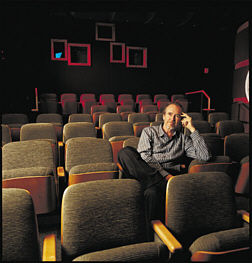






 |
||||
 |
 |
 |
 |
 |
 |
||||
|
S E P T E M B E R 2 0 0 1 I S S U E The Big Question |
|
|
Photo by Michele A. H. Smith
|

Q: What's the Scariest Movie You've Ever Seen?
Director and screenwriter
Wes Craven (MA '64)
"What movies scared me the most? How about all those World War II newsreels I was taken to when I was 4 or so. Cities in flames, suicide bombers diving down smokestacks of exploding battleships, civilians weeping or fleeing. The fact is, anything scary I've seen in commercial scary movies pales in comparison to the terrifying things I've seen in documentary footage. "In the '50s it was government films of atomic bombs vaporizing the troposphere. Then hydrogen bombs. Test houses disintegrating, trees whipping horizontal. When I was at Hopkins, in 1963, it got even more personal. The president of the United States was assassinated, and shortly after we were treated to film of his head exploding while his wife looked on in horror. This was soon followed by clips of the deaths of Martin Luther King and Bobby Kennedy, and all made it perfectly clear that the enemy, as Walt Kelly once said, was us as much as them. When I was a college professor, it was footage from Vietnam--dinnertime glimpses of postmodern warfare that abandoned all reason or decency. "The 20th century was, in fact, the first cinematic century, and nothing could have prepared our minds for what its real footage taught. We all have those sorts of images seared into our brains, from Little Rock, Cambodia, Jonestown, Rwanda, Bosnia--and countless other places and times when we watched civilization evaporate in the white heat of homicidal madness. "I mention all this unpleasantness for a reason. Modern horror films, of which I am admittedly a practitioner, are to me simply post-traumatic nightmares of a world that has seen more horror than it can handle alone. Why do people pay good money to go into a theater and to be terrified by a movie? They don't. They're already terrified by real life. What they go into that theater for is to have the terror of real life marshaled into some sort of order, so it can be dealt with. The chaos is caged for a few hours in a graspable narrative. And the hero or heroine makes his/her way through the worst we all can imagine and comes out on the other side not only alive, but steeled by that most basic of realizations--that survival is within us all. That this is all experienced in an informal community of peers, in a half-dreamlike state where personal fear is suddenly shared fear, is exhilarating. "And pretty ancient, too. There is very little difference in my mind between Freddy or Jason and the Minotaur or Cyclops. The art of telling scary stories to challenge the night goes back to the very dawning of language and art. "So with that in mind, I'll just mention one last piece of scary footage I've seen--that of several prominent senators ranting that storytelling about darkness should be banished because it causes folks to go out and actually do dark things. I believe it's the other way around, guys. And as a matter of fact, one or two of you have been willing participants in some of the most violent episodes in modern history. And what movie made you do that?" |
 |
|
 The Johns Hopkins Magazine | The Johns Hopkins University |
3003 North Charles Street |
The Johns Hopkins Magazine | The Johns Hopkins University |
3003 North Charles Street | Suite 100 | Baltimore, Maryland 21218 | Phone 410.516.7645 | Fax 410.516.5251 |
|